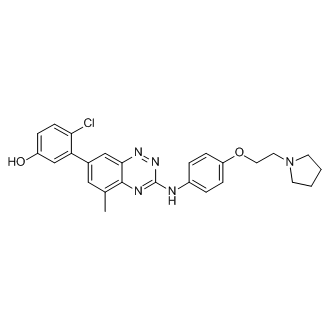| Size | Price | Stock |
|---|---|---|
| 100 mg | Get quote | |
| 250 mg | Get quote | |
| 500 mg | Get quote | |
| We match the lowest price on market. | ||
We offer a substantial discount on larger orders, please inquire via [email protected]
or Fax: (86)21-58955996
Inquiry for price and availability only. Please place your order via our email or fax.
| Cat. No. : | HY-10184 |
| M.Wt: | 475.97 |
| Formula: | C26H26ClN5O2 |
| Purity: | >98 % |
| Solubility: | DMSO : ≥ 150 mg/mL (315.15 mM) |
TG 100572 is a multi-targeted kinase inhibitor which inhibits receptor tyrosine kinases and Src kinases; has IC50s of 2, 7, 2, 16, 13, 5, 0.5, 6, 0.1, 0.4, 1, 0.2 nM for VEGFR1, VEGFR2, FGFR1, FGFR2, PDGFRβ, Fgr, Fyn, Hck, Lck, Lyn, Src, Yes, respectively. IC50 & Target: IC50: 2 nM (VEGFR1), 7 nM (VEGFR2), 2 nM (FGFR1), 16 nM (FGFR2), 13 nM (PDGFRβ), 5 nM (Fgr), 0.5 nM (Fyn), 6 nM (Hck), 0.1 nM (Lck), 0.4 nM (Lyn), 1 nM (Src), 0.2 nM (Yes)[1] In Vitro: TG 100572 shows sub-nanomolar activity against the Src family as well as RTK such as VEGFR1 and R2, FGFR1 and R2, and PDGFRβ. TG 100572 inhibits vascular endothelial cell proliferation (ED50=610±71 nM) and blocks VEGF-induced phosphorylation of extracellular signal-regulated kinase. TG 100572 induces apoptosis in rapidly proliferating, but not quiescent, endothelial cell cultures[1]. TG 100572 is shown to inhibit hRMVEC cell proliferation, with an IC50 of 610±72 nM. This suggests that TG 100572 has the therapeutic potential to inhibit VEGF function in ocular endothelial cells, a contributing factor to pathological angiogenesis in diseases such as AMD and PDR[2]. In Vivo: Systemic delivery of TG 100572 in a murine model of laser-induced choroidal neovascularization (CNV) causes significant suppression of CNV, but with an associated weight loss suggestive of systemic toxicity[1]. A concentration of 23.4 µM (Cmax) of TG 100572 is reached in 30 min (Tmax)=0.5 h) in the choroid and the sclera. However, the levels of TG 100572 in the retina are relatively low. The half-life of TG 100572 in ocular tissues is very short; hence, the compound is administered topically minimum t.i.d. to maintain appropriate drug levels in the eye. The maximum concentration one can achieve in formulations using TG 100572 is 0.7% w/v[2].
Lorem ipsum dolor sit amet, consectetur adipisicing elit. Autem earum hic iste maiores, nam neque rem suscipit. Adipisci consequatur error exercitationem fugit ipsam optio qui, quibusdam repellendus sed vero! Debitis.
Inquiry Information- Product Name:
- TG 100572
- Cat. No.:
- HY-10184
- Quantity:


Your information is safe with us.